Story and photos by Ronda J Green, PhD (chair Wildlife Tourism Australia)
This is a very personal account of my own memories of Binna Burra and what it has meant to me. Many others who have loved the lodge. its people and its forests will have their own stories
Binna Burra Lodge, at the edge of Lamington National Park, was burned to the ground in a recent fire, but all are determined it will rise from the ashes.
(Binna Burra home page https://www.binnaburralodge.com.au)
Binna Burra convinced me s a young teenager from Adelaide that I wanted to live in southeast Queensland. It also inspired me to start a holiday farm in the Adelaide Hills offering nature studies, bush walks and campfire singalongs as well as horsemanship lessons and trail rides. Later it convinced me that ecology was the topic I wanted to study at university.
The first thing that captivated me was the rainforest. Growing up in Adelaide, the driest capital in the world’s driest continent, I enjoyed bush walks in the Adelaide Hills but had long dreamed of jungles since reading Rudyard Kipling’s “Jungle Stories.” I also listened to my mother’s stories of exploring the forests with her many brothers and sisters on her family’s dairy farm in the Tweed Valley.
I still recall my thrill at the first epiphytic ferns I saw on the trees as our car neared Binna Burra. My mother wasn’t enjoying the drive quite so much. She wasn’t keen on my father’s driving especially on mountain roads with sharp drops at their edges. Her apprehension wasn’t helped as we came around one corner to see an evangelist had attached a large sign to a tree saying “Prepare to Meet Thy Maker.”
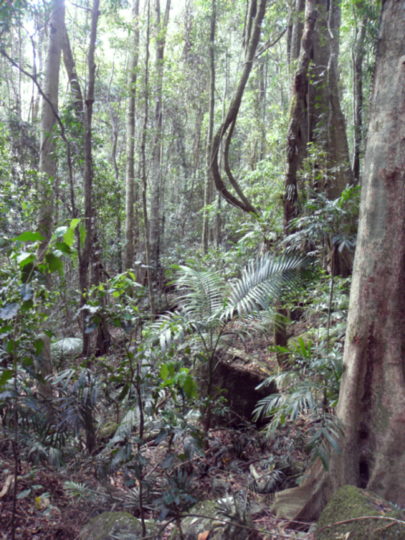
As soon as we’d settled into our heritage cabin of thick logs, I hurried to the edge of a rainforest track and stepped inside, immediately overwhelmed by the height of the trees and the abundance of life – vines climbing everywhere, mosses on lower trunks, big ferns on higher trunks … life upon life all around. I could hear strange birds and was later to find they were male and female whipbirds calling to each other. Then a little rufous fantail appeared just in front of me, fluttering around acrobatically catching flying insects. I still have a soft spot for rufous fantails – the first bird I ever encountered in a rainforest.
When I returned to the cabin, my mother had something to show me, knowing my fascination with all living things: a leech she had carefully caught and kept in her hand without letting it attach to her. Later she took her shoe off and saw a sock full of blood – she didn’t realise she had carried another for me!
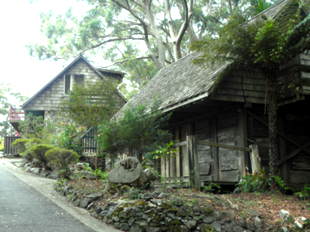
Almost every day I walked in the forests, usually with my schoolfriend Lyndall, who had come with us for the holiday, sometimes alone and sometimes as part of a guided hike. My parents came with us on the Caves Track, and we enjoyed a packed lunch sitting in Kweebani Cave, wind-eroded into volcanic rock, and historically used by local people of the Yugambeh language clan for sheltering and cooking. The White Cave felt like entering Fairyland – consisting of white tuff so we were surrounded by a sort of dream-like whiteness.
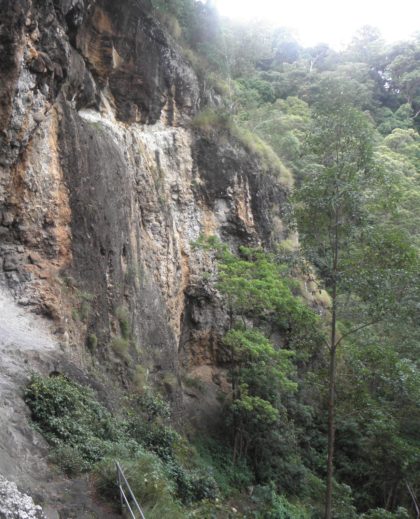
Lyndall and I joined a half-day horse-ride, which made me determined to do a full-day ride. I had only cantered half a dozen times in my life, so was not an experienced rider. My horse – a tall, handsome palomino – was somewhat lazy, lagging well behind the others and then trotting to catch up. When they cantered, he would keep up not at a canter but at a fast trot. I enjoyed the ride immensely, looking own on green forest-edged homelands and dreaming of living somewhere like that some day, but I did a lot of trotting, and it was just as well that was our last day, as I could hardly walk for the next couple of days.
Another day that tested my endurance was the trek to Shipstern, led by Tony Groom, son of Binna Burra’s founder Arthur Groom. Relentlessly up and up, with experienced hikers from University of Queensland, several years older than me, and I had to sit down, catch my breath, run to catch up then sit gasping again, and then lie on my back throughout lunch. I was fine for the downhill part that followed, which included climbing down a cliff attached to a rope, feeling my way around a huge boulder to a rocky ledge from which we had to transfer to a tree and descend to the next ledge. Down in the valley we hitched a ride on a milk truck (I think) to Natural Bridge, where we enjoyed a barbecue and a walk through the forest at night to see the sky of pale green stars which was really a colony of glow-worms under the over-hanging rock, reflected in the water below. The camaraderie that developed between us – a small group of humans in the wilderness – made me want to share this feeling with others, one of the glimmerings of the idea of the holiday farm I later ran for two and a half years.
Deep feelings clutched me during the Daves Creek Country walk. We had descended through rainforest, eucalyptus forest and sheoak forest and finally through low mallee-heath country, and stopped for a rest at Surprise Rock, gazing out across the valley and cliffs beyond. This is Australia before colonisation I thought, before any roads and buildings, maybe even before Aboriginal arrival. This was the first time I had stared out across such a large tract of country with no sign of human presence.
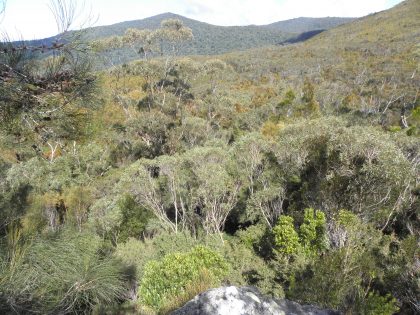
At night we sometimes joined a campfire singalong on the hillside. I still remember “I witsh I wath a widdle thwiped thkunk,” “Oh you can’t get to Heaven in a Holden car”, “On Ilkla Moor Bacht Hat,” “Oh Sir Roger” and others we sang along with Tony and the uni students. Other nights I sat quietly in the library, and recall being delightfully encouraged by one of the books I read which implied something along the lines of quiet, thinking, nature-loving people (qualities for which I had often been criticised, for being an “odd” child) being able to lead changes for the betterment of the world, giving me some confidence I might be able after all to achieve something worthwhile, despite all the comments by relatives.
I enjoyed nipping out into the forest before breakfast, standing alone amongst the trees, feeling somehow accepted by the forest in a way I often wasn’t in built-up areas. I appreciated the advertisement I later saw in the Wildlife Australia magazine, advertising Binna Burra, showing the high-rise of Surfers’ Paradise with the query “Paradise?” and the rainforest with the exclamation “Paradise!” I laughed at the call of the catbirds, thinking birds just shouldn’t sound like that.
I loved the lodge itself as well. What was then the dining hall (sometimes converted to a dance hall after dinner) was later to become the lounge-room (below) when a new dining hall was built. I was amused at the convention at mealtimes that if when asked which of several choices you wanted you responded not with a choice but “yes please” you got a bit of everything. Sitting and chatting by the fire at night brought feelings of cosiness and friendship, and when I played the piano I was delighted to find music for such songs as “The Shifting Whispering Sands” that I had so often listened to on the radio.
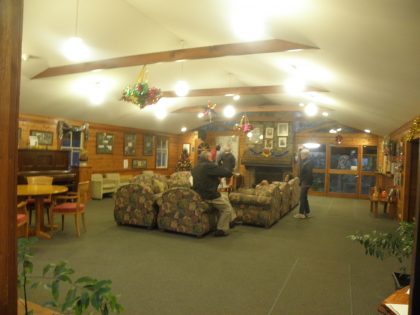
After returning to Adelaide, whenever we had visitors from Brisbane I’d ask them about Binna Burra, and was mystified by those who had never visited. I remember thinking what’s the use of living in Brisbane if you don’t goto Binna Burra?
A few years later I flew back to Queensland to attend the Wildlife Preservation Society of Queensland Spring School run by Judith Wright, poet, conservation activist and then president (and co-founder) of the Wildlife Preservation Society of Queensland.
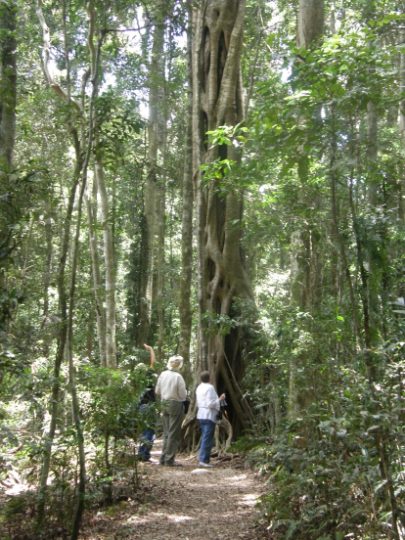
Judith Wright, with her passion for nature, had been one of my favourite poets throughout high school (I had by now left school and was running the holiday farm I’d dreamed of). I felt highly honoured to now be walking and talking with her through the rainforests. One day an elderly lady pointed upwards at a tall strangler fig and said “Who’s the youngest here who can shoot up there for a photo?” Thinking she was joking I said I guessed I’d be the youngest (I was 19), and was somewhat alarmed when she said quite seriously, “Okay, up you go!” I didn’t want to admit in front of Judith that I was too scared, so I somehow made it to the top (I never even got a copy of the photo). The worst part was coming down again, not being able to see where to put my feet. I was especially honoured a few days later as I came in for breakfast when Judith announced “Ah, here comes our hope for the younger generation!” I hope she’d be pleased to know that, as well as being chair of Wildlife Tourism Australia, I’m also now chair of the Scenic Rim branch of the Wildlife Preservation Society of Queensland (she also lived for about 20 years in the Scenic Rim, and for WPSQ’s 50th anniversary a few years ago we held a special night of poetry and artworks, in which we read some of her poems as well as current local poets and displayed current nature artwork).
I got a bit of a reputation for being adventurous that week. On a free morning I joined a horse-ride and because I was more experienced by then than the others the leader suggested I head off on my own. The pony was quite frisky, and I suddenly realised we were dancing around at the edge of Bellbird Lookout, from which there had been a fatal fall in the past. I quickly urged him uphill and because he wanted to go faster than I did we travelled in a sort of sideways half-trot half-canter for most of the way back. Next day he somehow got out of the paddock and joined us at the start of a rainforest walk. I put my belt around his neck, borrowed a belt from one of the men, led him down the hill to the gate, then, not wanting to get too far behind the walkers, climbed onto the fence and onto his back and cantered up the hill, controlling him with the two belts. When I mentioned this later to a girl who had been riding there a fair bit she said “which horse did you say?” I told her and she crossed herself saying “Holy Mary, Mother of God.” Apparently that horse had a reputation for bad behaviour.
I had ridden own my horse in Adelaide several times past the Waite Institute, enjoying the open air and looking in through the windows at all the white-coated people in the laboratories, thinking I wouldn’t want to study zoology at the university, as I imagined it to just involve dissecting and classifying things. A talk during the Spring School about the science of ecology convinced me that although part of the time would be spent on those activities I could also be studying the behaviour of animals outdoors in the wilderness, and also indulge in my interests not only of zoology but also botany, geology and mathematics. I enrolled for a science degree, talked my way into it with the Faculty Advisor (who was worried that I’d been away from school too long and hadn’t done the now-mandatory with year of high school), majored in zoology and botany and was one of the first females to conduct field research for my Honours degree, spending a total of 12 weeks alone in Flinders Chase National Park on Kangaroo Island studying the behavioural ecology of honeyeaters. My PhD later involved suburban birds, but for my post-doc I was was once more back in my beloved rainforests, including those of Binna Burra, studying the birds that dispersed seeds of rainforest plants.
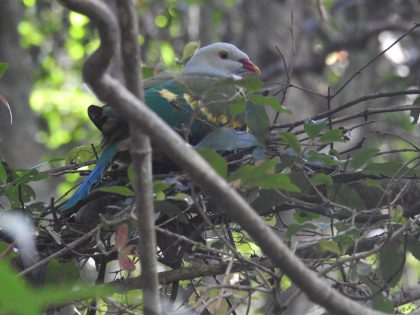
By then I was living in Queensland. After lecturing for a couple of years in Central Queensland, I took my husband and infant daughter to Binna Burra for a fortnight’s camping holiday, and they also loved it. My daughter said her first-ever sentence there: “I like trees.” After our tent blew down in the middle of the night in a wind storm, which she had slept through until I rushed her out as the tent collapsed, she also looked around and said “Wind. Fun!”, which wasn’t exactly how we were feeling about it just then. We looked for and found a property just to the west of Lamington National Park, where we still live. My son at the age of six months had his first camping trip there, and now helps to lead birdwatching and other wildlife tours there. I was soon afterwards employed by National Parks to run a season of interpretive activities while my son was still at an age to be crawling on hands and knees after brush turkeys.
Wildlife Tourism Australia has held three events here – a general workshop in the early 2000’s, the launch (by Bradley Trevor Grieve, author of the “Blue Day Book” and “Priceless”) of our Southern Queensland Wildlife Trail map, and most recently the workshop “Enjoyable, Meaningful, Memorable: Using Wildlife Interpretation To Do It All” run by Drs Betty Weir and Rosemary Black.
—
Last month there was a fire – a severe fire driven by high temperatures and strong winds.
The lodge is gone. The old cabins are gone. The library … still hard to believe. So many times I have walked into that lodge feeling I was coming into a second home. So many memories. I keep feeling as though I should be able to walk into that room again, be greeted by friendly people I’ve come to know over the years, settle into one of the sturdy old cabins built over 80 years ago …
I was pleased at least to hear the old dinner bell had been found intact. It may not sound like much, but for all of us who have heard that big bell so many times summoning us to breakfast or dinner, it was refreshing to hear the occasional bright note. Also that the campground largely survived, as did the adjacent cafe and the old house of the Groom family.
Most of the rainforest is okay but the extensive open forest on the downhill side and some of the adjacent rainforest has been severely burned. Wildlife Tourism Australia has donated $200 to emergency supplementary feeding of animals (and Lamington Natural History Association has followed suit), especially for the small insectivorous vertebrates such as log-runners, scrubwrens, lizards and antechinus (loss of insect life is a big problem after fires) and for the pademelons that are accustomed to coming from the forest at dusk to feed on grass that is now burned. We are experimenting with motion-sensing cameras to find ways of feeding these animals without feeding the currawongs that prey on nestlings and could make life even harder for the small birds we’re trying to help.
Manager Jo Weir says she’s thinking of this disaster not as an end but as a mid-point. We’ve just experienced the first 86 years of Binna Burra, now the re-building will start and we’ll look forward to the next 86!
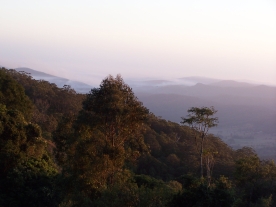

I had the opportunity to visit Binna Burra several times. For me as a city boy, from the Netherlands, I was overwhelmed by the nature of Lamington National Park. Over ythe years, I did all the walks, some of them with you Barry in the early days. I have great memories of all the people I have met during these years. Hazel, the cook, Chris Duncan and many others, Binna Burra was a place where you could completely unstress. I hope the rebuilt site will be able to create the same atmosphere as the old Binna Burra
Hi Ronda, it was so interesting to read about your memories of Binna Burra. We feel exactly the same way about that Heavenly place. We remember you very well – particularly the time when all our tents blew down. I met you for the first time when you were trying to wash the mud off your little daughter in the toilet block. Our son Michael was very friendly with Dione – we haven’t met your son. Hope that you, Dennis, Dione and Darren are all well. Hilary and Frank Hussey.
Thank you for sharing your story about how Binna Burra influenced your life. Mine is a little different but the effect is just as profound. I arrived by chance in 1981 and I am still here. Binna Burra has been my life and my family’s life for 38 years. Wendy and I met there, we married there and raised our boys there. It has been a fortunate life.
We have stood in the ruins of Binna Burra and cried but we have also remembered the good times. So many good times. Wonderful memories.
Yesterday I walked a short distance along the road towards the information centre, a walk I have done many times, and there in a sparsely leafed tree was my old buddy, a Koala. I see him often and he is usually asleep but this time he was sitting up looking at me with his hand in the air as if he was waving. How he, and another Koala nearby, survived when some of the hottest fires went through their territory is a mystery, a miracle. At Bellbird Lookout I found the charred jaw bone of another Koala that wasn’t so lucky. That area has been severely burnt yet from a hollow in one of those trees an Owlet Nightjar popped its head out and called. Among the wreckage of Cabin 41, Honeymoon Cottage, Nigel the long term resident Satin Bowerbird, is rebuilding his bower just as Binna Burra will rebuild.
Please note Binna Burra is not open to the public. I had special permission to go there. I am also the custodian of the bell and I am pleased to say it sounds better than it has for years.